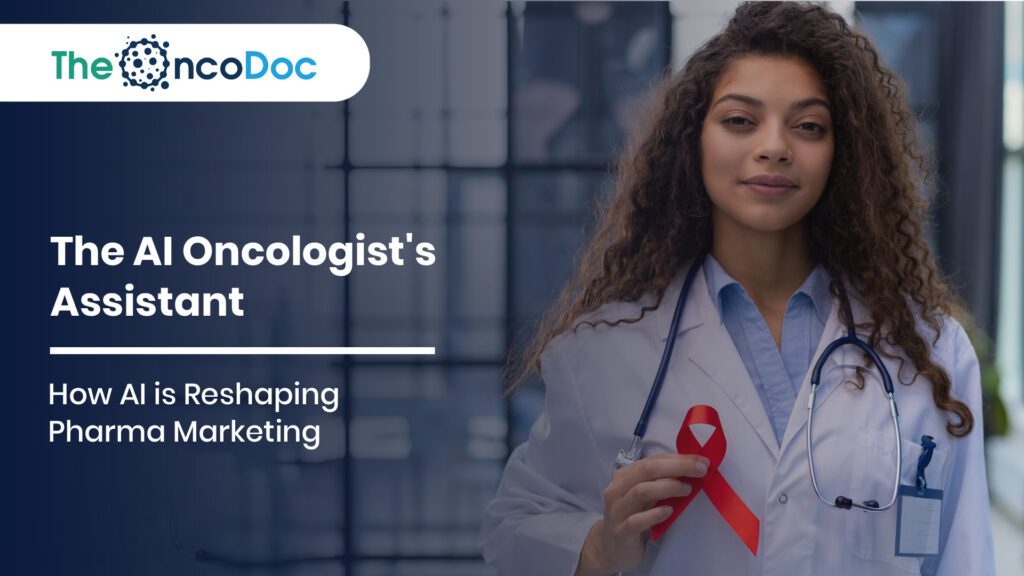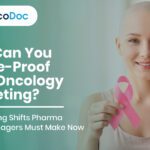Introduction: When Algorithms Become Allies in Cancer Care
Oncology has entered a new era where artificial intelligence (AI) is no longer confined to the research lab, it is embedded in every stage of patient engagement, physician decision-making, and pharma marketing strategy. The “AI Oncologist’s Assistant” is not a single tool but a symphony of data-driven technologies, from predictive analytics to personalized content engines, that help bridge the gap between medical innovation and real-world patient outcomes.
In this AI-powered landscape, pharma marketers are no longer just storytellers, they are becoming orchestrators of precision outreach, delivering the right information, in the right tone, to the right individual, at the right time. The stakes are high: prompt, precise communication can literally save lives, and cancer is still one of the leading causes of mortality worldwide.
This article explores how AI is acting as an oncologist’s assistant in reshaping pharma marketing, transforming campaigns from mass-media awareness drives into intelligent, patient-first interventions. It also examines the ethical balance between personalization and privacy, the integration of AI into existing healthcare ecosystems, and the real metrics that now define success.
1. From Broad Campaigns to AI-Precision Targeting
Traditional oncology marketing often relied on demographic targeting, broad campaigns aimed at age groups or geographic regions. The AI Oncologist’s Assistant changes this completely. By processing real-time patient data, search behavior, wearable device metrics, EMR patterns, AI can segment audiences based on their exact intent stage.
For instance:
A patient repeatedly searching “painless lump in breast” on multiple platforms could trigger breast cancer awareness ads in their local language.
A caregiver researching “immunotherapy success rates” could receive a case study video from survivors who underwent similar treatments.
This intent-based segmentation ensures marketing messages resonate more personally, improving engagement and early detection rates.
2. AI-Driven Predictive Screening Campaigns
One of the most impactful roles of the AI Oncologist’s Assistant is in predicting where and when awareness campaigns should run. By integrating search engine data, hospital admission trends, and even social chatter, AI can forecast cancer awareness needs before they become urgent.
Example: In a district where Google searches for “chronic cough” spike alongside increased local clinic visits for respiratory issues, AI may predict a rise in potential lung cancer cases. Within a few days, pharmaceutical companies can start micro-campaigns, disseminating screening camp schedules through local radio, WhatsApp, and SMS.
This proactive approach turns pharma marketing into a preventive public health intervention, not just a promotional exercise.
3. The AI-Powered GP Engagement Model
General practitioners (GPs) are the first line of defense for early cancer detection. Yet many lack updated oncology knowledge. The AI Oncologist’s Assistant offers a personalized GP learning engine, tailoring micro-learning modules to a GP’s patient demographic and local cancer patterns.
If a GP in rural Bihar sees high tobacco usage among patients, their AI dashboard might prioritize modules on oral cancer early detection. A general practitioner in metropolitan Delhi, on the other hand, would be given brief instruction on genetic testing for breast cancer risk.
The result is knowledge in context, making GP referrals timelier and more accurate.
4. Patient Emotion Mapping Through AI
AI sentiment analysis now extends beyond customer reviews, it can analyze patient fears, hopes, and hesitations through social media posts, chatbot interactions, and support group discussions.
If the AI Oncologist’s Assistant detects increased anxiety about chemotherapy side effects in a region, pharma marketers can adapt campaigns to include survivor reassurance stories, nutrition guidance, and side-effect management tips.
This empathy-driven marketing aligns messages with emotional readiness, not just medical facts, making campaigns more effective and less overwhelming for patients.
5. Multilingual, Hyperlocal AI Campaign Deployment
Cancer awareness messaging loses impact if the audience doesn’t understand it culturally or linguistically. AI translation engines, fine-tuned with medical vocabulary, can now generate region-specific campaign content in seconds.
An artificial intelligence (AI) system in Tamil Nadu can convert an English breast cancer awareness poster into culturally appropriate Tamil-language video advertisements with local influencers. In Northeast India, it can adapt oral cancer messages into Assamese folk-song formats.
Hyperlocal AI marketing ensures that no patient is left behind due to a language issue.
6. AI Chatbots as 24/7 Oncology Assistants
AI-driven chatbots have evolved from FAQ machines into virtual oncology companions. Available on WhatsApp, mobile apps, and hospital websites, they:
Conduct symptom pre-assessments.
Book screening appointments.
Provide medication reminders and nutrition guidance.
For pharma marketers, these chatbots are also insight goldmines, revealing common patient concerns and trending misinformation, allowing rapid campaign adjustments.
7. Real-Time Campaign Adaptation
The AI Oncologist’s Assistant enables the AI Continuous campaign A/B testing. If Spanish-language survivor videos outperform English ones among Hispanic patients in Texas, the switch can happen instantly.
Likewise, if a certain call-to-action, “Book a Free Screening”, outperforms “Check Your Cancer Risk,” AI can roll out the winning copy across all active campaigns within hours, not weeks.
This agility ensures campaign relevance stays at peak levels, avoiding wasted ad spend.
8. Integrating Genomic and Biomarker Data into Outreach
With more patients undergoing genomic profiling, AI can tailor marketing based on specific biomarkers. A patient identified with BRCA1 mutation could receive content about preventive mastectomy and targeted therapies, while an EGFR-positive lung cancer patient might see resources on advanced tyrosine kinase inhibitors.
This level of scientifically precise communication builds brand credibility and empowers patients to make informed choices in partnership with their oncologists.
9. AI-Powered Myth-Busting in Cancer Awareness
Misinformation about cancer spreads rapidly. AI social listening systems identify falsehoods in real time, such as “MRI causes cancer” or “herbal cures for cancer,” and then launch fact-based counter-capaigns with survivors and physicians.
These myth-busting interventions prevent harmful delays in seeking medical treatment and position pharma brands as trusted knowledge partners.
10. Voice-Activated Oncology Education
Smart speakers and voice search are emerging as unanticipated oncology marketing trends. AI assistants like Alexa or Google Assistant can deliver localized cancer awareness briefings, symptom quizzes, and even screening reminders.
For patients with low literacy, voice AI offers equal access to critical health information, breaking educational barriers that printed materials cannot.
11. AI-Supported Patient Journey Mapping
The AI Oncologist’s Assistant can map the entire patient journey, from first symptom search to post-treatment follow-up, identifying key decision points where targeted engagement can make the most difference.
If AI detects a high dropout rate between initial diagnosis and treatment initiation, pharma marketers can introduce psychological counseling content or financial aid information at that exact stage to improve treatment uptake.
12. Oncology Wearables and AI Health Alerts
Wearables integrated with AI can detect subtle changes, like decreased activity levels, abnormal sleep patterns, or weight loss, and flag them for both patients and healthcare providers.
When linked to pharma apps, these alerts can trigger timely educational nudges about relevant cancer screenings, making AI not just a marketing assistant, but a health guardian.
13. KPIs in the AI Marketing Era
In the age of the AI Oncologist’s Assistant, success metrics go beyond impressions and clicks.
These KPIs measure impact on patient health behavior, not just marketing reach.
14. Survivor Story Optimization with AI
AI can analyze which survivor narratives resonate most, by demographic, language, and even emotional tone. It might find that short, hopeful stories work best for younger audiences, while longer, detailed journeys resonate with older patients.
Pharma marketers can then match the right story to the right audience, maximizing emotional connection and trust-building.
15. AI Ethics in Oncology Marketing
While AI offers immense potential, ethical safeguards are crucial.
Key principles include:
Informed consent for data use.
Avoiding exploitation of patient fear for marketing gain.
Transparent AI content labeling.
Responsible AI marketing ensures trust remains at the core of patient engagement.
16. The Future: Predictive-Preventive-Participatory Oncology Marketing
The AI Oncologist’s Assistant will evolve toward anticipatory care, detecting pre-intent signals like changes in fitness tracker data or subtle symptom-related search trends before the patient even considers screening.
In the next decade, AI could power:
Digital twins of patients to test therapy outcomes virtually.
Community-level cancer risk forecasting.
Fully adaptive campaigns that self-optimize in real time.
This future is not just about selling treatments, it’s about saving lives through precision outreach.
Alright , I’ll extend “The AI Oncologist’s Assistant: How AI is Reshaping Pharma Marketing” with 6 additional, well-aligned points (about 800 words), keeping the same tone, depth, and structure so it reads as a seamless continuation of your existing 3000-word article.
17. AI-Powered Clinical Trial Recruitment
One of the most challenging aspects of oncology drug development is finding eligible patients for clinical trials. Traditional recruitment is slow, heavily dependent on physician referrals, and often misses diverse populations. The AI Oncologist’s Assistant can analyze EMR data, genomic reports, and even social media activity to identify potential trial candidates in real time.
For example, a patient posting in a support group about recently testing positive for a specific mutation could be flagged (with consent) for outreach regarding trials targeting that biomarker. This not only accelerates recruitment but also increases diversity in trial participation, ensuring therapies are tested in broader demographic and genetic populations.
Pharma marketers benefit by integrating trial awareness into patient education campaigns, creating a pipeline of informed, eligible participants that supports both research and brand credibility.
18. AI-Assisted Health Literacy Enhancement
Even the most well-designed oncology campaigns fail if patients don’t understand the information being shared. AI-driven health literacy tools can simplify complex medical jargon into patient-friendly explanations, while preserving accuracy.
For example:
An AI engine could convert “HER2-positive metastatic breast carcinoma” into “a type of breast cancer where certain growth signals are overactive, often treatable with targeted medicines.”
Interactive AI visualizations can show how treatments work inside the body, making complex mechanisms relatable.
This approach is especially valuable for underserved communities where health literacy is low. By bridging the knowledge gap, pharma marketing can empower patients to participate actively in their treatment decisions, which has been shown to improve adherence and outcomes.
19. AI-Supported Caregiver Engagement
Caregivers, often family members, play a critical role in cancer care but are rarely a primary focus of pharma marketing. The AI Oncologist’s Assistant can track caregiver interaction patterns (e.g., frequent searches for nutrition tips, financial aid programs, or emotional support groups) and deliver tailored resources directly to them.
Caregiver-specific outreach might include:
Stress management webinars.
Printable medication schedules.
Guidance on navigating insurance paperwork.
By recognizing and supporting caregivers as part of the extended patient ecosystem, pharma companies position themselves as partners in the entire care journey, not just treatment delivery.
20. AI-Driven Budget Optimization in Campaigns
Marketing budgets in oncology are significant, but traditional allocation methods can waste resources on underperforming channels. AI’s predictive analytics can forecast ROI per channel and audience segment before campaigns even launch.
For instance, if AI predicts a 60% higher conversion rate for WhatsApp outreach in a specific rural district compared to Facebook ads, budget allocations can be dynamically adjusted in real time. This ensures that every marketing dollar is tied directly to measurable health outcomes, such as increased screening rates or treatment adherence.
21. AI-Powered Multimodal Storytelling
Not all patients consume information the same way. Some prefer short videos, others like detailed articles, and some engage more with interactive tools. The AI Oncologist’s Assistant can analyze engagement history to decide whether a patient should receive a quick Instagram Reel, an interactive symptom checker, or a long-form survivor interview.
Example: A 28-year-old urban professional might engage more with a 60-second animated explainer about immunotherapy side effects, while a 65-year-old retiree might prefer a downloadable PDF booklet with detailed treatment options.
In addition to boosting content engagement, multimodal customisation guarantees that audiences receive important health information in the format of their choice, which enhances action rates and retention.
22. AI as a Bridge Between Pharma and Tele-Oncology
The rise of tele-oncology, virtual consultations for cancer care, has created new opportunities for AI-assisted pharma marketing. AI can integrate with telehealth platforms to provide patients with personalized educational resources before and after their virtual appointments.
Imagine this flow:
Before the consult: AI sends a patient a checklist of questions to ask their oncologist.
After the consult: AI delivers a follow-up packet summarizing the key discussion points, along with brand-sponsored resources relevant to their diagnosis and stage.
This integration extends the impact of tele-oncology sessions while reinforcing pharma brands as trusted, patient-centered knowledge partners.
Conclusion
By incorporating these advanced applications, spanning trial recruitment, literacy improvement, caregiver engagement, budget optimization, personalized storytelling, and tele-oncology integration, the AI Oncologist’s Assistant is cementing its role not just as a marketing tool, but as a cornerstone of patient-centric oncology ecosystems.
The overarching theme remains clear: AI in pharma marketing is moving beyond awareness to direct, measurable improvements in cancer care outcomes, where every campaign touchpoint contributes meaningfully to earlier detection, better treatment adherence, and improved survival rates.
The Oncodoc team is a group of passionate healthcare and marketing professionals dedicated to delivering accurate, engaging, and impactful content. With expertise across medical research, digital strategy, and clinical communication, the team focuses on empowering healthcare professionals and patients alike. Through evidence-based insights and innovative storytelling, Hidoc aims to bridge the gap between medicine and digital engagement, promoting wellness and informed decision-making.



